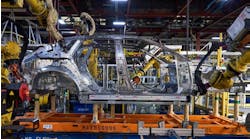At Lockheed Martin Corp. (IW 50/19) innovation is a concept that means more than bringing new technologies to the marketplace. The aerospace and defense contractor based in Bethesda, Md., deploys its research and development expertise to drive plant-floor efficiencies and cut costs in the manufacturing process, as well as find new market solutions.
Lockheed Martin's leading role as a manufacturer in the nanotechnology space is one example of a company leveraging its technical prowess to develop enabling and revenue-generating manufacturing technologies. Nanocomposites have been incorporated into the wingtip fairings of the company's F-35 Joint Strike Fighter, resulting in "significant cost savings," says Steve Meier, vice president of new business initiatives
The company received approval in 2011 from the F-35 Joint Program Office to substitute a nanostructure thermoplastic material for a considerably more expensive continuously reinforced carbon fiber wingtip fairing, says Travis Earles, Lockheed Martin's senior manager for advanced materials and nanotechnology initiatives. The technology, called Advanced Polymers Engineered for the Extreme (APEX), was part of an effort to develop lighter-weight materials under a manufacturing cost-reduction initiative.
"We were able to significantly reduce the cost of the part, and as an extension of that make a significant impact in the fleet production cost with that single part," Earles says. The company would not specify how much it has saved with the new wingtip fairing material.
Lockheed Martin has identified more than 100 additional parts for potential APEX insertion into the F-35 to achieve additional cost savings, Meier says. The company also is examining other platforms within its portfolio that may benefit from APEX. With Department of Defense budget cuts looming, Lockheed Martin is under increasing pressure to reduce costs. "In a constrained budget environment, technology investments must have direct impact on future growth," Meier says. "Nanotechnology has already demonstrated the potential to improve performance while simultaneously reducing costs."
Keeping Competitive with New Technologies
A potential $500 billion reduction in government defense spending would "devastate the industry," Lockheed Martin President and COO Christopher Kubasik told The Wall Street Journal in a May 1 article. Kubasik will replace Robert Stevens as CEO on Jan. 1. But Kubasik said in the article that the company's role in developing emerging technologies will be a factor in its ability to remain globally competitive.
But the company is not trying to become a materials manufacturer, Earles says. Its primary area of expertise is in technology development and systems integration. That's where partnerships become crucial. For example, Lockheed Martin formed a nanotechnology research center with Rice University in 2008 called LANCER and continues to search for other partners with expertise in various technologies.
"We recognize we are not going to drive this innovation bus by ourselves," Earles says. "So moving from discovery to development to deployment is going to be critically dependent upon our ability to engage other players with other areas of expertise, particularly for production."
See also:
Lockheed Martin CEO Bob Stevens to Retire
Nanotechnology: Beyond the Hype
Lockheed Martin Missiles and Fire Control, Lufkin Operations: IW Best Plants Profile 2011



